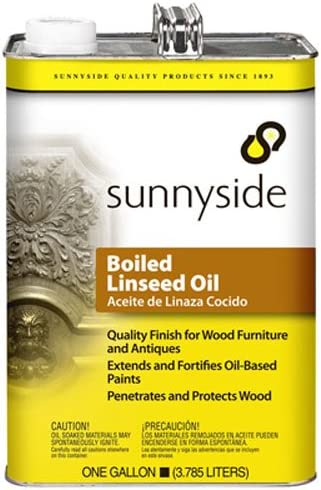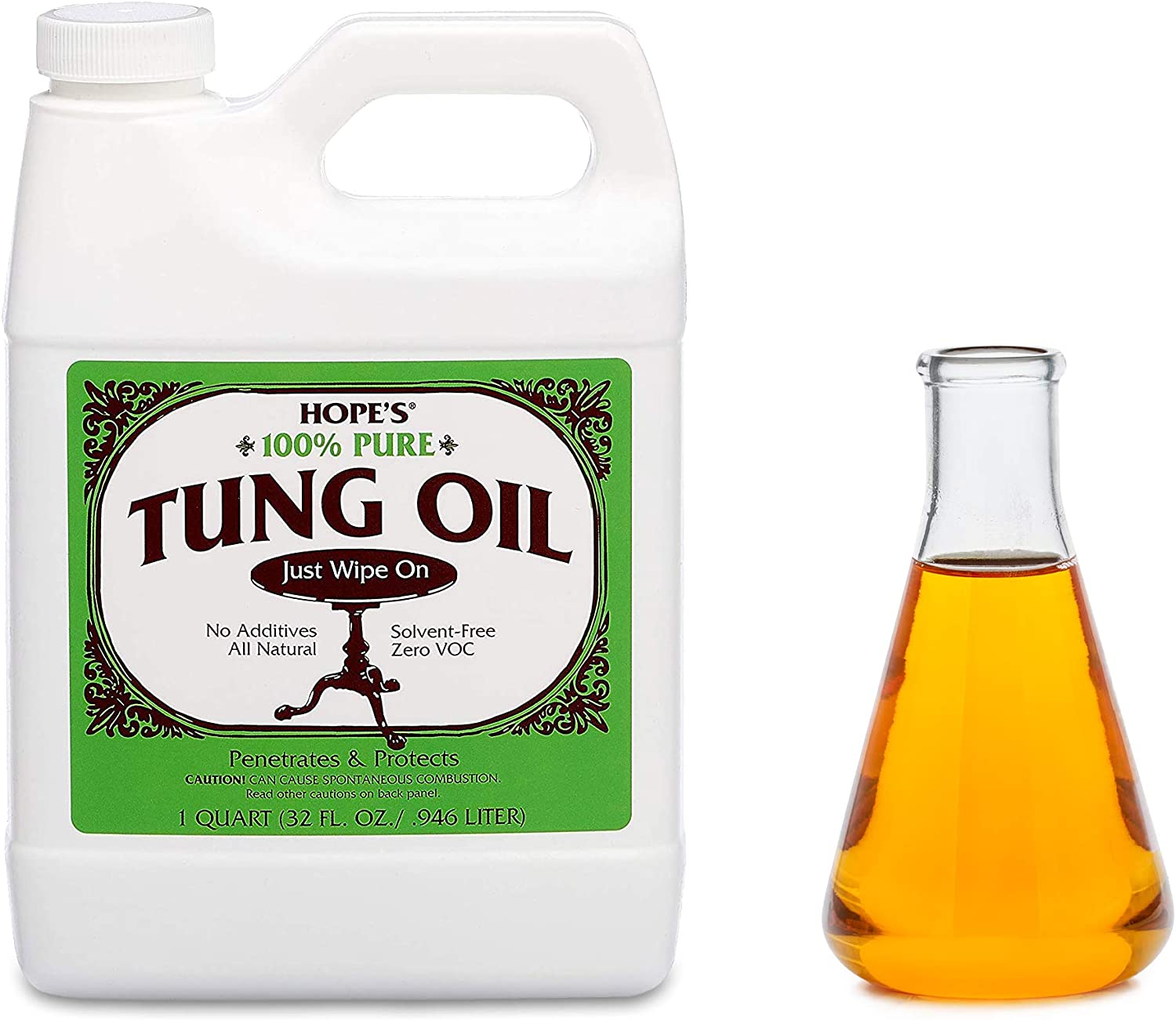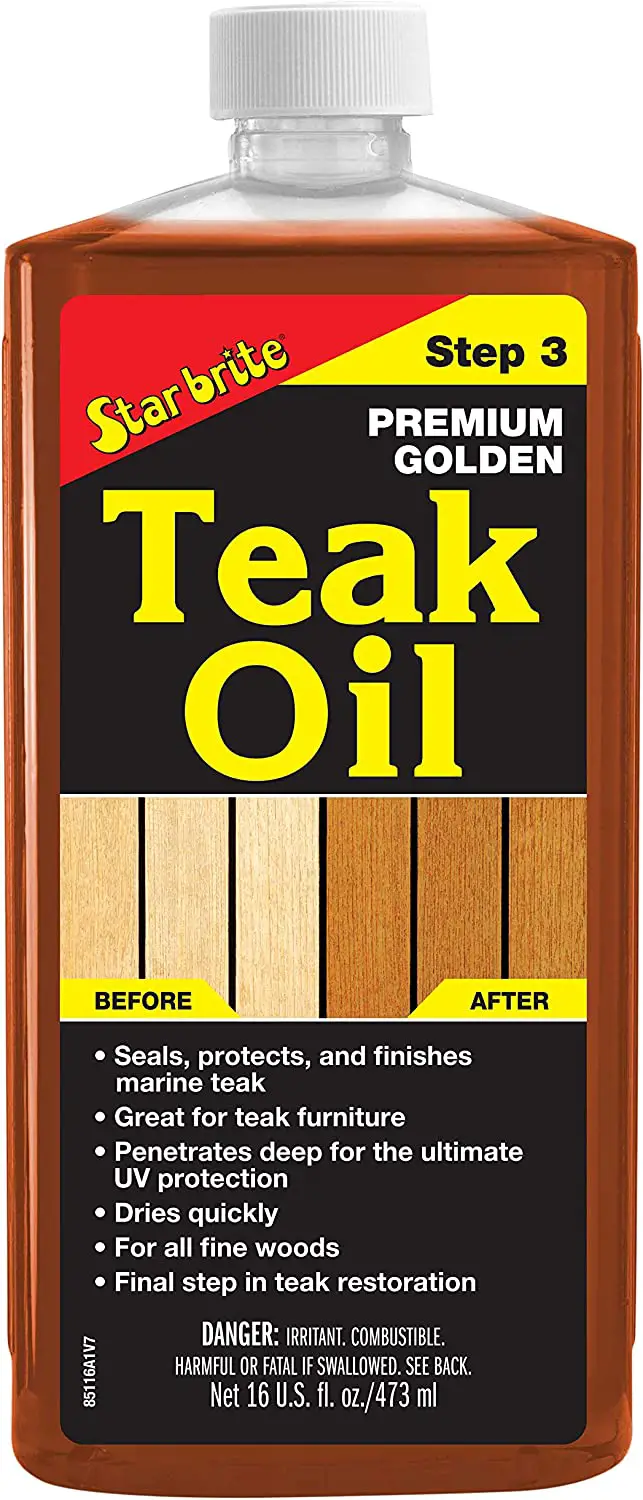The best axe handle finish is a blend of boiled linseed oil and beeswax. Linseed oil penetrates and nourishes the wood, while beeswax adds a protective layer and enhances grip. Apply several thin coats, allowing each to dry before the next application, for a durable and comfortable finish.
Axe handles look better and last longer when they’ve been given a good layer of finish. This is a definitive guide to the top finishes for axe handles out there, as well as a how-to guide to giving your axe handle that attractive, protective finish. The handle treatments mentioned in this guide are easy and simple to apply. Good axe handle finishes seal the wood grain, help repel moisture and prevent mildew and rotting, improve your grip on the handle, and improve and preserve the look of the wood.
The finish is essential maintenance for your axe – or any other wood-handled tool – and a few minutes of work and a few more hours of drying will add years to your axe handle’s lifespan. If you want to find out how to replace your axe handle, this guide will help you with that. Without further ado, let’s get into it.
If you’re short on time, I’ve added a comparison table of axe handle finishes on the market below with comments for each of them. Read on to find out more!
- 128 ounce can
- Most Popular
- Cheapest option
- Takes longer to dry
- 32-ounce bottle
- Better water resistance
- Better mildew resistance
- 16-ounce bottle
- Less smell
- Dries fast
- Well-regarded
Table of Contents
Oil Finishes
For wood finishes, oils are divided into drying and non-drying oils. It’s what it sounds like – drying oils (linseed, tung, teak, hemp, walnut oils) dry out the wood, repel moisture, and prevent mildew and rotting. This is what we want. Non-drying finishes such as olive, coconut, and other oils do not prevent moisture for penetrating the wood, and aren’t a good choice as a finish for your axe handle. If all you have are non-drying oils, take the extra day or two to order a drying oil – you’ll be glad you did and it makes so much more sense than trying to apply an olive oil finish to your axe handle.
| Axe Handle Oil Finish | Advantages | Disadvantages |
| Boiled Linseed Oil | Most popular and cheapest finish. | Apply wearing gloves. |
| Tung Oil | Better water resistance. | More expensive than BLO. |
| Teak Oil | Smells less and dries faster than BLO. | Gives a lighter finish. |
| Hemp Oil | Doesn’t change the wood’s color. | Can leave the wood very light. |
| Walnut Oil | Doesn’t contain chemical additives. | Most expensive option. |
Boiled linseed oil
Boiled linseed oil (BLO) is the most popular and cheapest wood finish. It has additives and drying agents to speed the drying process. Raw linseed oil is thicker and, without additives, provides less protection against mildew. It also takes much longer to dry. Due to health concerns, some people prefer to use raw or organic linseed oil. Both (and all finishes in general) are best applied using gloves. Finally, linseed oil (both boiled and raw) can be mixed with additives such as pine tar, turpentine, and beeswax (more on those later). If it is heated and applied warm, penetration is improved.
Boiled linseed oil is the best oil for axe handles due to its combination of high performance and low.
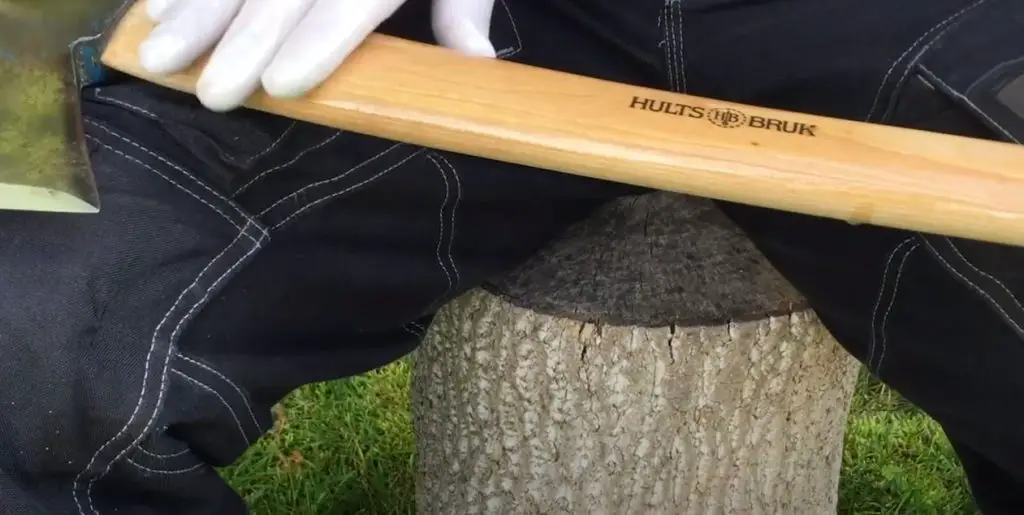
Tung oil
Pure tung oil is another great choice for an axe handle finish. Due to its molecular structure, it provides better water and mildew resistance than linseed oil.
Teak oil
Teak oil is another well-regarded drying oil for tool handles and furniture. It is much less thick, smells less, and dries faster than linseed oil (boiled or raw).
Hemp oil
Hemp oil is good at highlighting the natural beauty of the wood – it doesn’t change colors as much as other oils do. Light wood will remain light, while darker parts will be accented. It is also hypoallergenic, making it a good choice for those concerned by the presence of metallic or chemical additives in other finishes.
Walnut oil
Walnut oil is a light, food-grade finishing oil traditionally used for wooden eating utensils and bowls, but it also works great as a finish for axe handles and other wooden tools. Walnut oil doesn’t contain any metallic or chemical additives.
Wax finishes
Beeswax is the most popular wood finish out there for axe handles. Waxes are generally the easiest to apply and require almost no drying and cleanup whatsoever. You just rub them into the wood, let them dry, and buff them with a soft cloth. They come off a lot quicker than oil finishes, though.
Tar Finishes
Pine tar is the one and only tar finish you should be putting on your axe handle. The highest grade pine tar is known as Stockholm tar, and was used for waterproofing wooden ships. That is the main purpose and benefit of pine tar – it makes your wooden handle highly resistant to moisture and the damage it can cause, as well as protecting against any nosey insects that might try to burrow into the wood. It also gives the wood a beautiful dark patina. Pure pine tar is extremely thick, though, and is most often diluted and blended with linseed oil.
Additives
Additives are often mixed in with boiled linseed oil to add extra, positive properties to the finish. Oftentimes drying oils come with some additives in them already – check when you’re buying, it should be stated on the label. Pine tar, for example, provides mildew protection and extra water resistance, aids with the grip, and gives the axe handle a nice dark color. Turpentine – another pine product – improves the penetration of the oil, allowing it to get deeper into the wood with a single layer or soaking. Beeswax fills in the surface pores of the wood, providing a better sealing and extra water resistance – although keep in mind that the wax will have to be removed with a light sanding before more oil can be applied, or it will repel the oil.
If you want to mix it up yourself, heating the boiled linseed oil is recommended, after which you can add the tar or other additives into it and stir it out. Heating will make the liquid finish less thick and viscous – pine tar by itself, for example, is just very thick tar that is an absolute pain to apply.
An example mix that many people use is 8 parts boiled linseed oil to 1 part pine tar and 1 part turpentine.
How to apply finish to your axe handle
There are two main methods to applying a finish to your axe handle – soaking and layered application (or brushing). The process is essentially the same – getting finish onto your axe handle and allowing it to penetrate into the wood fiber. Since hardwood such as hickory soaks up oil slowly, it’ll take a while either way if you want to give your handle a nice deep finish. Soaking requires less hands-on attention, while brushing requires more but allows you to use the tool faster, in between finish layers if you choose to do so.
Applying axe handle finish by soaking
Soaking is exactly what it sounds like – you take the axe handle, stick it into the finish, and leave it there. Some people leave it for as long as seven days or until the axe handle stops soaking anything up. You can put the handle into a bucket vertically if the handle is short enough and you have enough finish, or you can lay it down onto a tray if it’s longer and cover it with oil. That’s the main drawback to soaking – you need a lot of finish if your axe handle is large. Some people will soak the head end of the handle and brush the rest of the handle.
In any case, leave the handle soaking for as long as possible (although if it’s only a day or so, you should go for brushing). After a week the wood will not soak up any more oil. At that point take the handle out, wipe it down, and leave it to dry. It’ll take longer to do so because of the saturation, but it will be worth it.
Applying axe handle finish by brushing
Brushing is what most people go with and it is also what it sounds like. Take a brush, dip it in the finish, and apply it up and down the handle. Gently wipe down the excess and leave it to dry. Penetration with this technique is low, so you should apply several layers of finish for several days. You should aim to apply at least three layers of finish to your axe handle. This might take a couple of days, but it’ll be well worth it.
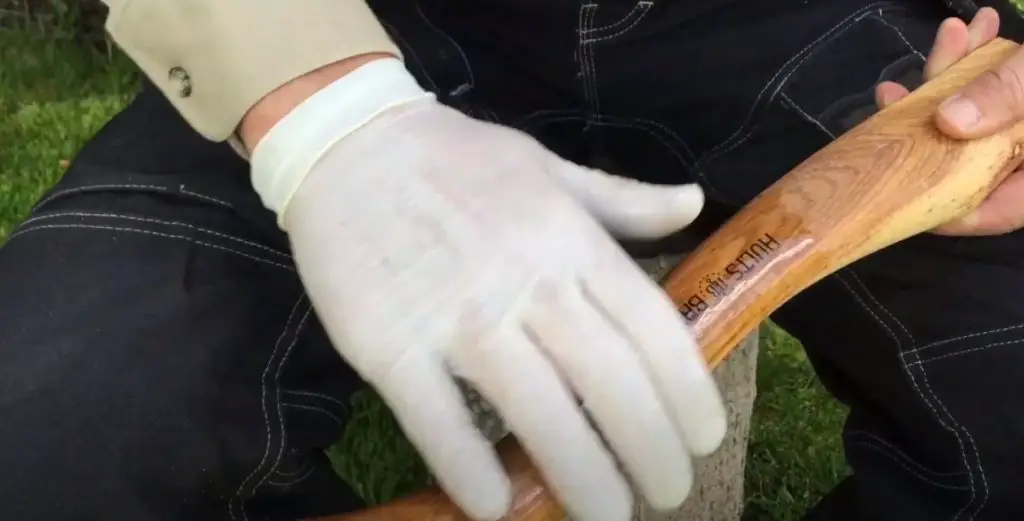
Safety tips when oiling your axe handle
The main tip is to prevent fire – don’t bunch up your rags that you apply or wipe the oil finish with and throw them into the trash wet. This is because they can spontaneously combust. If there is pine tar or turpentine in the mix, it can create a very violent flame in a place where you need and expect it least. Leave your rags unfolded and flattened out to dry – then you can toss them safely.
The second is to use gloves if you have sensitive skin or suspect that you might. The finish oils, with the additives they often contain, can irritate your skin.
The best time to apply finish to your axe handle is when it’s dry and sunny outside. If that’s not possible, at least do it in a dry place. The axe handle will take less time to dry and prevent moisture from getting in. Doing it when it’s dry will also ensure that the ambient moisture in the air is lower, and the wood of the handle will evaporate moisture, not absorbing it.
How often should I oil an axe handle?
A popular method for finishing a brand new axe handle is to apply boiled linseed oil once per day for the first week, then move to once per week for a month, and finally once per month for a year. After that, you should only need to sand the handle with 500 grit sandpaper and re-apply annually.
How many coats of oil for an axe handle?
You should target at least 3 coats of boiled linseed oil to get the best finish for your axe handle. This may take several days to complete but it will give the best color finish and most water resistance.
That’s all! Thanks for reading, and good luck with giving your axe handle a beautiful and functional new finish!

